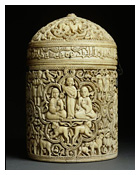|
|
 |
 |

|
| Islamic art is a complex field. It reflects the creative and intellectual energy and the richness of a civilization that spanned thirteen centuries and three continents, from Spain to India. Islamic civilization comprised diverse cultural and linguistic groups, including Arabs, Persians, and Turks. The political history of this cultural entity is tumultuous, oscillating between periods of stability when art and literature flourished, and periods of invasion that left only chaos and destruction in their wake. |
|
Islamic society was founded on the strict separation of roles. Power was in the hands of a warrior elite, who alone bore arms and protected the rest of the population in exchange for the payment of taxes. The great majority of artistic commissions came from the circles of power; many religious buildings, for example, were financed by political leaders. Very few commissions were made by merchants or religious figures. |
|
The objects that have come down to us therefore reflect a "courtly art." A certain aesthetic unity makes them instantly recognizable, whatever their period. This unity was fostered by intensive exchanges within the Islamic world, crisscrossed by trade routes that were also followed by artists and craftsmen; it was further reinforced by common distinguishing features, such as the decorative use of calligraphic writing and a distinct fondness for geometric design. But Islamic art cannot be defined by these elements alone. Figurative decoration was another important aspect of many art forms such as metal and ceramic arts and the art of the book. |
 |
 |
| © Photo RMN - © H. Lewandowski |
 |
Underlying this unity, however, was a profusion of artistic styles and schools. Each period and region introduced its own innovations, giving its artistic production a strong visual identity. From the brick architecture of Iran to the stone buildings of Egypt, from the rigorous geometry of Mamluk art to the flowing, plant-like motifs of Mogul India, a wide range of aesthetic choices flourished during the various periods of Islamic art. |
|
 |